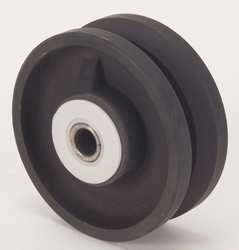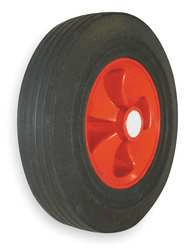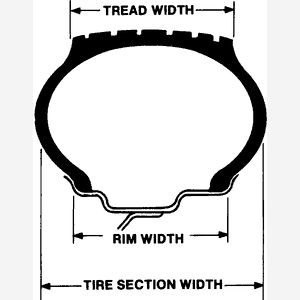Wheels Information
Description
Wheels are solid discs or rigid circular rings that attach to assemblies such as casters to allow movement. They are connected to a hub and designed to turn around an axle.
Types
There are several types of industrial wheels.
-
V-grooved wheels can ride on tracks or floors and provide superior traction due to their V- shape.
-
Flanged track wheels can also ride on tracks, but cannot travel on floors because the flanges mounted on each side of the wheel limit the bearing surface area.
-
Pneumatic wheels are filled with air for better shock absorption and usually consist of a rubber tire on a metal rim. Tube and tube-less versions are available.
-
Phenolic wheels are created by applying heat and pressure to layers of paper or glass cloth impregnated with synthetic resin.
 Materials
Materials
Some industrial wheels are made from solid materials such as plastic, polyurethane, stainless steel, and rubber. Others are made of one type of material and mounted on a hub constructed of a different material. For example, polyurethane wheels are available with metal or plastic hubs. Some industrial wheels resist chemicals, oils, greases, petroleum products, and solvents. Others are resistant to chipping, cracking, and the flat spotting that can occur when a vehicle is parked for a long period of time. Industrial wheels with half round treads are commonly available.
Performance Specifications
Selecting industrial wheels requires an analysis of load and size specifications.
-
Load capacity is the maximum weight that wheels can bear.
-
Hub length is the distance from one side of the hub to the other.
-
Operating temperature is the full-required range of ambient temperatures for environments in which industrial wheels are used.
Product Specifications
Other important specifications include
-
Wheel diameter describes the diameter or size of the wheel. Wheels with larger diameters roll more easily and are suitable for moving along floors with cracks and other surface impediments.
-
Wheel tread width is the distance between the outer edge and the inner edge of the tread of a new tire. A general rule is to select a tire with a tread width within +/- 1/2 inch of the wheel width.

-
Bore or bearing size describes the size of the receiving hole of the wheel.
-
Bearing type can vary based on the rotary application of the wheel.
-
Weight determines how much of a load the wheel can carry.
-
Color can be based on style or need for identification.
Design Tip: In general, heavier loads require larger wheels.
Applications
Industrial wheels are used in a variety of applications and industries. Products that are designed for heavy equipment such as earth movers, forklifts, trailers, moveable machinery, and motorized vehicles can support a variety of load capacities. Industrial wheels that are suitable for laboratory or general industrial use are also available. Sanitary products meet the requirements of regulatory agencies such as the Food and Drug Administration (FDA) or the U.S. Department of Agriculture (USDA). These industrial wheels are typically installed on equipment used in food processing plants, bakeries, restaurants, and commercial kitchens.
References
Image Credits:
- blower wheel
- solid rubber wheels
- cast iron handwheel
- retractable caster wheel
- rotating wheels
- v belt pulley wheel
- feed wheel
- omni wheel
- roller wheels track
- trolley wheel
- v groove wheel
- encoder wheel
- flanged track wheel
- u-groove polyurethane wheels
- bench grinder wheel
- chair caster wheels
- heavy duty cart wheels
- multidirectional trolley wheel
- track wheel
- 1 inch bore wheel
- bidirectional wheel
- conveyor drive wheel
- forged steel wheels
- hand wheel torque
- incremental encoder wheel
- multi directional wheel
- rotary encoder wheels
- spring loaded wheels
- threaded stem caster
- heavy duty omni-directional wheel
